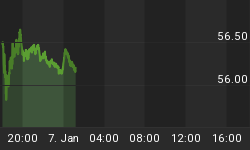Gold & Euro Fall in Sync on "Risk Aversion", Physical Dealing Hits Summer Lull
SPOT GOLD PRICES reversed an early 0.8% bounce Tuesday lunchtime in London, drifting back to $936 an ounce as the Euro currency, commodities and world stock markets dipped on worse-than-expected US housing data.
Home-improvement giant Home Depot reported only a 7% drop in its second-quarter earnings. But new US housing starts and permits for July came in below both Wall Street forecasts and June's figure.
Nationwide, according to analysis from First American CoreLogic, almost a third of US home-buyers now owe more on their mortgage than their house is worth.
"We saw risk-money withdrawn from the markets on Monday," says Toshima Itsuo of the World Gold Council, writing for Mitsubishi Bank in Tokyo. "The foreign exchange market matched investors' risk reduction in falling stock prices."
Today the Euro fell back towards Monday's two-week low of $1.4050, while government bond prices turned higher after an earlier slip, pushing 10-year US Treasury yields towards yesterday's one-month low of 3.48%.
Crude oil stalled at $67.35 per barrel. Tuesday's London Silver Fix came in almost $1 below last week's two-month high of $15.07 per ounce.
The monthly correlation of daily Gold Prices with the Euro's US-Dollar value has average more than 0.92 across the last 3 weeks. A perfect correlation would read 1.0.
"In terms of gold as a commodity, product demand is weak," says Itsuo, "but demand for gold as a financial asset will continue to expand.
"Early next month marks one year since the Lehman Bros. shock, and a recurrence of that financial crisis, if it comes, is likely from September to October."
Matching the typical summer lull in Gold Prices, meantime, data from the London Bullion Market Association showed on Monday that trading volumes in the wholesale gold market were "well below" May and June during July,
Dropping by 13.6% month-on-month, the number of ounces transferred between LBMA members - heart of the world's professional gold dealing - fell in July to its lowest daily average since December at 17.7 million.
The June-to-July period between 1997 and 2008 saw London gold volumes drop 8% on average.
Best estimates reckon total trading in London's wholesale gold market is three times the LBMA's reported volume, suggesting a daily value last month of $16.5 billion.
As the value of global gold trading rose towards last year's record of $20.25 trillion - more than four times the value of all the gold ever mined in history - Gold Futures and options have accounted for an ever-greater share of the market, rising from less than 7% to more than a quarter in 2008.
"Physical demand saw some improvement [last month]," says Scotia Mocatta, "but the pickup was not widespread. There may now be areas of pent-up demand."
In India - the world's hungriest physical gold market, but where jewelry sales have sunk by more than one-half since 2008 - exchange-traded funds saw investment-cash inflows rise 32%, says the Business Standard, during the first 7 months of 2009 compared with 2008.
"Fundamentally, the factors that will cause Comex Gold Futures to breakout are still undetermined," says Matt McKinney at the Zaner brokerage in Chicago, "but I believe that it's going to be a weaker US Dollar Index.
"Only about 12% of the [US] stimulus money is in circulation. It seems inevitable that with that much money still left, the overwhelming supply of US Dollars could cause inflation."
With crude oil hitting its record peak of $147 per barrel 12 months before, July's US producer price data today showed a drop of 6.8% year-on-year.
The UK's consumer-price data surprised City analysts, however, by holding flat - rather than falling - and compounding June's unexpected month-on-month increase of 0.3%.
UK investors looking to Buy Gold saw the price drop to a one-week low beneath £570 an ounce.















